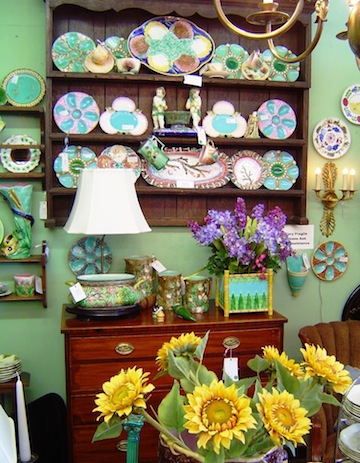
We hear from many folks interested in Majolica that are wanting to start a collection or add to a current collection; their questions range from “What is Majolica” to “Who Makes Majolica” to “Why is Majolica so Expensive” so we thought there just might be more folks out there with the same interest and questions and we hope this article will provide a bit of insight into this delightful collectibles arena for you.
What is Majolica?
Majolica is a tin or lead glazed earthenware ceramic formed with plaster of paris molds and kiln fired multiple times in various stages to create the deep and brilliant colors specific to Majolica. It’s these amazing colors and variety of whimsical shapes and forms that make this ceramic truly stand apart from other collectibles. Majolica was created by ceramist Herbert Minton in the mid 1800s and was first shown to the public at the Great Exhibition in London in 1851. The Victorians adored Majolica.
Master Creators of Majolica
The types of Majolica that collectors seek does not always have an identifying mark or signature but most noted English creators are: Minton, Holdcroft and George Jones, and Wedgwood. The most recognized American name is Griffin, Smith and Hill, (Etruscan).
Many Majolica artists were inspired by nature when creating these treasures. Ocean themes of shells, fish, and oysters, farm animals, fruits and uniquely colored plants and leaves are some of the styles you will find Majolica formed into it. Majolica oyster plates, majolica sardine and cheese boxes, majolica asparagus plates and majolica asparagus platters etc..Truly amazing!
Why is Majolica so Expensive?
Majolica values range from hundreds to thousands of dollars and even damaged pieces can hold their value if they’re made by any of the creators mentioned in this article. Because these pieces are so rare today and highly collectible – the market place has driven up the cost and on these antique treasures not to mention the amount of skill and detail that went into creating these masterpieces.
Majolica reproductions are in the market place today and so “buyer be ware” when paying large sums of money for pieces. Consult with a Majolica expert or seek out the many books on Majolica, it pays in the long run when you do your due diligence.
Conclusion
The appeal of collecting Majolica fills many books, homes and cabinets across the world and we hope you found this little article helpful in providing a glimpse into the arena of Majolica. For a detailed photos and information visit here – your eyes will be delighted with the Gorgeous Majolica!!

